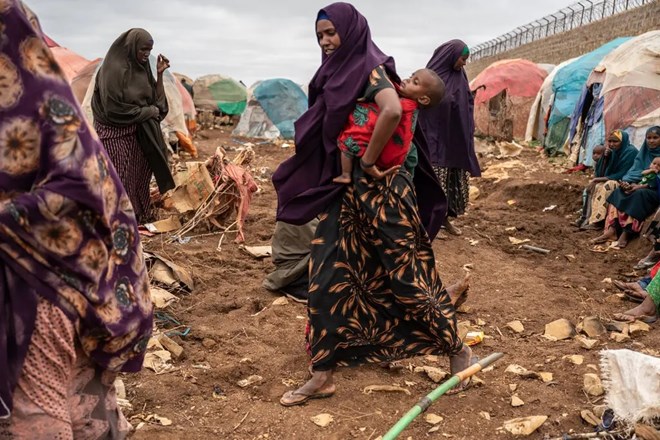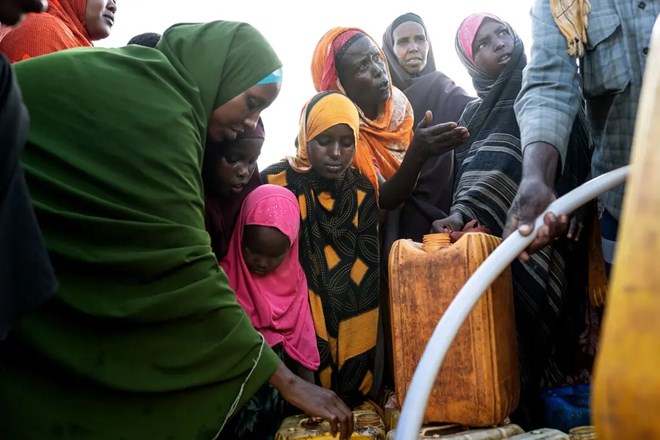
Tuesday November 22, 2022
By Declan Walsh
Photographs by Andrea Bruce
The worst drought in 40 years is pushing Somalia to the brink. If it triggers a rare famine declaration, the militant group Al Shabab will also be to blame.

“I’m begging Allah not to take another baby from me.” A day after the death of her 3-year-old daughter at a camp in Baidoa, Somalia, Faduma Adan Abdirahman held her newborn son tight.
The sea of rag-and-stick tents that spreads in every direction from the hungry, embattled city of Baidoa, in southern Somalia, gives way to sprawling plains controlled by the militants of Al Shabab.
Over 165,000 refugees have streamed into Baidoa since early last year, fleeing the ravages of Somalia’s fiercest drought in 40 years. Among them was Maryam, a 2-year-old girl whose family had lost everything.
The drought withered their crops, starved their animals and transformed their modest farm into a howling dust bowl. They endured a five-day trek to Baidoa, braving Islamist check posts, hoping to reach safety.
But one recent afternoon Maryam, weak from hunger and sickness, began to cough and vomit. Her mother, cradling Maryam in her arms, called for help.
Calamity beckons in Somalia, where a combination of extreme weather and extremists is driving the country toward its most serious humanitarian disaster in over a decade. Five seasons of failed rains, linked to climate change, have hit 7.8 million Somalis, 300,000 of whom are experiencing severe starvation.
But weather alone doesn’t create famine, experts say — it takes people, too. The biggest obstacle to a massive relief effort is the presence of Al Shabab, the extremists who dispatch suicide bombers and forcibly recruit children, tax farmers and prevent aid groups from reaching the worst-hit areas.

Dome-shaped tents spread in every direction from Baidoa, a city surrounded by forces from the Al Shabab militant group in southern Somalia.
Somalis are waiting to see if aid experts will formally declare a famine in the coming weeks. Many already fear that history is repeating: Somalia’s last two great famines, in 1992 and 2011, which killed half a million people between them, were also the product of drought supercharged by war.
Designated levels of hunger mean nothing for Maryam, who died just before sunset on Nov. 3. Men from the camp carried her remains, wrapped in a donated shroud, in a quiet procession to a small graveyard on the edge of Baidoa. A small twig with green shoots marks her grave.
Her mother, Nurtay Nurow, remained behind in their tent, mourning the third child she has lost to the drought.
“I felt so helpless,” she said the next day, resigned yet dry-eyed, her two remaining sons sitting silently by her side.
It has been a year since Somalia’s government declared the drought a national emergency, but aid workers say the crisis is now critical. Every minute, on average, a severely malnourished child is admitted to a health facility for treatment. Hospital wards are filling with starving children suffering from measles, pneumonia and other diseases that prey on the weak.
At least 1.1 million people have abandoned their homes for crowded, dirty camps like the ones around Baidoa. The U.N. says it needs an additional $1 billion for emergency food, water and shelter.

A camp for drought victims in Baidoa. The two-year drought has affected 7.8 million people in Somalia, twice as many as at the start of 2022, and about 21 million across the Horn of Africa, according to the United Nations.
Without urgent action, at least 500,000 children will be at risk of death by mid-2023, “a pending nightmare we have not seen this century,” the UNICEF spokesman James Elder said recently.
Kenya and Ethiopia are also victims of the unrelenting two-year drought, which has pushed 21 million people in the Horn of Africa to the brink. But the situation is most acute in Somalia, where a grim confluence of factors has turned a crisis into a catastrophe.
Scientists say that longer and more frequent droughts are a product of climate change caused by the emissions of countries that are far richer than Somalia, which emits practically nothing. In 2019, according to the World Bank, Somalia produced 690 kilotons of carbon emissions — 1/7,000 as much as the United States, which produced 4.8 million kilotons.
Trapped between hostile forces that seem either intangible or invincible, Somalis are shouting for help.
“If these kids don’t get what they need, they are going to die,” said an aid worker, Ali Nur Mohamed, at a feeding center in Baidoa funded by World Vision. Around him, women extended their shawls to collect sachets of a peanut paste that revives starving infants.
“There are shortages of food, of water — of everything,” he said.

A donkey cart brings water to a camp housing people who fled the drought in Baidoa, in southern Somalia. Residents grabbed containers and ran for the cart as soon as it appeared.

Leila Abdulrahman Ali, a volunteer teacher, leading a class in Baidoa for children forced to leave their homes by the country’s two-year drought. Ms. Ali lives in a tent nearby.
Baidoa, once known as the breadbasket of Somalia, has a decades-old association with famine. The skeletal bodies of the dead littered its streets in 1992, when a third of the town’s population starved to death over three months as failed harvests combined with a raging civil war. At the peak of the famine, 15 children died every day.
The tragedy prompted an ill-fated American military deployment to Somalia and a visit to Baidoa in 1993 by President George H.W. Bush, who hailed a “wonderful, wonderful mission of mercy” and vowed not to leave Somalis “in the lurch.”
But a year later the Americans had pulled out, following the infamous “Black Hawk Down” incident when Somali fighters shot down two American helicopters in the capital, Mogadishu.
A decades-long cycle of international interventions in Somalia, including billions of dollars in humanitarian aid and military support, have failed to stabilize the country. This year’s election of Hassan Sheikh Mohamud as president stoked new hopes that Al Shabab might be pushed back. But the militants retaliated on Oct. 29 with their deadliest attack in five years — a twin car bomb explosion in Mogadishu that killed over 100 people.
Baidoa, which the government recaptured from Al Shabab in 2012, has become a lifeline for the starving and the fearful. The U.N. said 165,000 people flooded into the city between April 2021 and July 22, adding to an existing refugee population of about 430,000. Arrivals since July, as yet unverified, number in the tens of thousands, U.N. officials say.
Baidoa’s crumbling streets are a maze of barriers and blast walls that resembles wartime Baghdad or Kabul. Aid workers travel in armored vehicles protected by armed guards.
Al Shabab’s influence begins within a few miles of the city limits, so foreigners are discouraged from lingering at relief camps or feeding centers for longer than 45 minutes.

Parched farmland on the outskirts of Baidoa, in southern Somalia. Previous droughts led to famine in 1992 and 2011.
We arrived by air, because the roads are too dangerous, and were usually back in our hotel by 3 p.m., for security reasons.
In the camps, new arrivals described harrowing journeys across desolate landscapes. Isaq Hassano, 75, enumerated his personal toll — first his son, who died in their village; then his son’s wife, who bled to death during childbirth on a 10-day walk to Baidoa; then a newborn child, who died after they reached the camp; and finally Nimo, a 3-year-old girl who starved to death a few months ago.
That left Mr. Hassano caring for orphans, whom his wife supports by begging in Baidoa city, he said.
“We need something,” he told me, through a translator. “Make some efforts.”
A group of aid experts known as the I.P.C., which classifies humanitarian emergencies, is careful about using the word famine. So far, they have found that no entire region in Somalia has crossed that threshold, although some aid workers privately dispute that finding. In the past decade only two crises have qualified: Somalia in 2011, and parts of South Sudan in 2017.
The next I.P.C. assessment is expected by the end of November. Several aid officials and a senior diplomat said they anticipated a possible famine declaration in several regions, including the one around Baidoa.
Certainly, the international response compared with 2011 has been swifter and better organized; aid groups like World Vision have capitalized on a decade of experience in towns like Baidoa, where Al Shabab are no longer in control. The United States has given $870 million in humanitarian aid to Somalia this year, a USAID spokeswoman said — far more than other donors.

Nurtay Nurow mourned her 2-year-old daughter, Maryam, who died at a camp in Baidoa on Nov. 3. Ms. Nurow, who had already lost two children in the drought, sat with her two remaining sons.
Still, the exploding crisis is rapidly outpacing those efforts. About 900,000 drought-affected Somalis live in areas controlled by Al Shabab, with no access to aid. Many are believed to have died in their homes or on the roadside. Food is scarce in overcrowded camps, and sanitation is poor, leaving the weak vulnerable to disease. Few can afford water: Until it rained briefly in Baidoa a few weeks ago, a tanker of water cost $100.
At the Bay Regional Hospital in Baidoa, Ahado Abdullahi held her ailing daughter in one arm and a battered cellphone in the other. She bought the phone, a Chinese model held together with an elastic band, with $4, she said. After the drought killed her family’s six cows and eight goats in a remote village, she relied on the phone to receive a monthly $10 transfer from a relative in Mogadishu.
But the price of a large cup of rice, enough to feed five people, quadrupled to 60 cents during the drought, she said. Then her relative fell on hard times, and the payments stopped. Four of her children died, the latest in July.
Now Ms. Abdullahi nursed her daughter Asli, a 1-year-old with peeling skin who sucked her fingers — a telltale sign of hunger — and, after eight days in hospital, weighed only 100 grams — about three and a half ounces — more than when she was admitted.
Women and malnourished babies registered for food aid at a nutrition center in Baidoa run by World Vision and Save the Children.
The forces driving Somalia’s misery are not abating. Meteorologists recently warned that model forecasts suggest the next rainy season starting in March could also fail, bringing a sixth consecutive season of drought.
Despite some recent gains by pro-government militias in central Somalia, Al Shabab remain formidable — even if their own fighters also suffer from the drought.
At Bay Regional Hospital, doctors identified several patients as the wives or daughters of Al Shabab fighters. They deserved care, even if the men in their families made the situation harder, a doctor added. But in nearby beds, other women described the extremists’ brutality.
One woman said she fled her home to avoid being forcibly married to a Shabab fighter. Another said militants shot dead her brother for helping others to escape their area. Others said nothing. In one camp, a man shushed his wife as she began to describe abuses by militants.
“People are listening,” he said softly. “Be quiet.”

A mother and her child at Bay Regional Hospital in Baidoa, which treats about 800 patients every day, up from 250 a year ago.